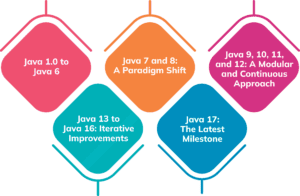

The World of Java: Java 17 and Previous Versions
Java, an omnipresent programming language, has evolved significantly since its inception in the mid-1990s. With the release of Java 17 and its predecessor versions, the language has not only witnessed groundbreaking features but has also solidified its place in the ever-changing landscape of software development.
The Journey Through Java Versions



- Java 1.0 was released in 1996, marking the debut of this revolutionary language. It brought forth the foundation of Java, introducing applets for web development and a groundbreaking promise of “Write Once, Run Anywhere.”
The subsequent versions, Java 1.1, 1.2 (Java 2), 1.3, 1.4, and Java 5 (or Java 1.5), introduced numerous enhancements. Java 5, for instance, introduced generics, annotations, and the enhanced “for” loop, fundamentally transforming the way developers wrote Java code. Java 6, released in 2006, brought improvements in terms of performance, scripting language support, and more.
Java 7 and 8: A Paradigm Shift
- The release of Java 7 in 2011 and Java 8 in 2014 was a significant leap forward. Java 7 introduced features such as the try-with-resources statement for better resource management, the diamond operator for more concise code, and more.
However, Java 8 was a game-changer, primarily due to the introduction of lambdas and the Streams API. This facilitated a shift towards more functional and modern programming paradigms. It also introduced the java.time package, offering a revamped API for handling date and time, overcoming the limitations of the legacy java.util.Date class.
Java 9, 10, 11, and 12: A Modular and Continuous Approach
- Java 9, released in 2017, brought the groundbreaking Project Jigsaw, introducing the module system to the language. This modularity aimed to enhance scalability, maintainability, and performance of Java applications. Java 10 and Java 11 focused on incremental enhancements and improvements in the JDK.
Java 12 introduced switch expressions, aiding developers in writing more concise and readable code. This version also embraced the preview feature concept, enabling early access to potential features under the “preview” status.
Java 13 to Java 16: Iterative Improvements
- The subsequent versions, from Java 13 to Java 16, predominantly concentrated on delivering incremental improvements. Java 13 introduced text blocks, a useful feature for writing multiline strings. Java 14 incorporated switch expressions as a standard feature, previewed in Java 12. Java 15 and Java 16 continued this trend of small, targeted enhancements, including features like sealed classes and pattern matching for the instance of operator.
Java 17: The Latest Milestone
- Java 17, released as the latest long-term support (LTS) version, further cements Java’s position as a cutting-edge language. It introduces several exciting features, including sealed classes and interfaces, enabling developers to restrict inheritance, enhancing security and design. It also includes pattern matching for switch, making code more readable and expressive.
Moreover, Java 17 comes with enhanced foreign function and memory APIs, enabling seamless integration with non-Java code and native memory. The introduction of extended support for the latest standard and preview features promises a stable and innovative platform for application development.
The Significance of Java 17 and Beyond
Java’s evolution through its various versions signifies a commitment to innovation while maintaining backward compatibility. Java 17’s release emphasizes not only the language’s ongoing development but also its robustness, security, and readiness for modern software development challenges.
Features’ Impact on Development
The additions of sealed classes, pattern matching, and foreign function and memory APIs in Java 17 facilitate cleaner, more secure, and efficient code. The ongoing improvement in the language ensures that developers can build robust, high-performance applications.
Adoption and Transition
The transition to Java 17 and subsequent versions might take time, considering the vast existing codebases on older versions. However, the long-term support for critical updates and new features in LTS versions encourages a smooth transition, fostering confidence among developers and businesses to embrace the latest releases.
Conclusion
Java’s journey from its early versions to Java 17 stands as a testament to its resilience and adaptability. The language continues to be a driving force in the world of software development, catering to a wide array of applications, from enterprise-level systems to modern cloud-based solutions and mobile applications.
With each new version, Java adapts to the evolving needs of developers and the industry, fostering innovation while maintaining its core principles of simplicity, portability, and reliability. The release of Java 17 and its continued evolution promises an exciting future for the language, solidifying its role in the dynamic and ever-expanding world of technology.
As we embrace the advancements in Java, it’s not just about the syntax or features; it’s a reflection of the language’s unwavering commitment to shaping the future of software development. The journey through Java versions stands as a testament to its lasting impact and enduring relevance in the realm of programming languages.
For more information Visit :
Blogger,
Pranav Umekar
SEED Infotech Ltd., Pune




